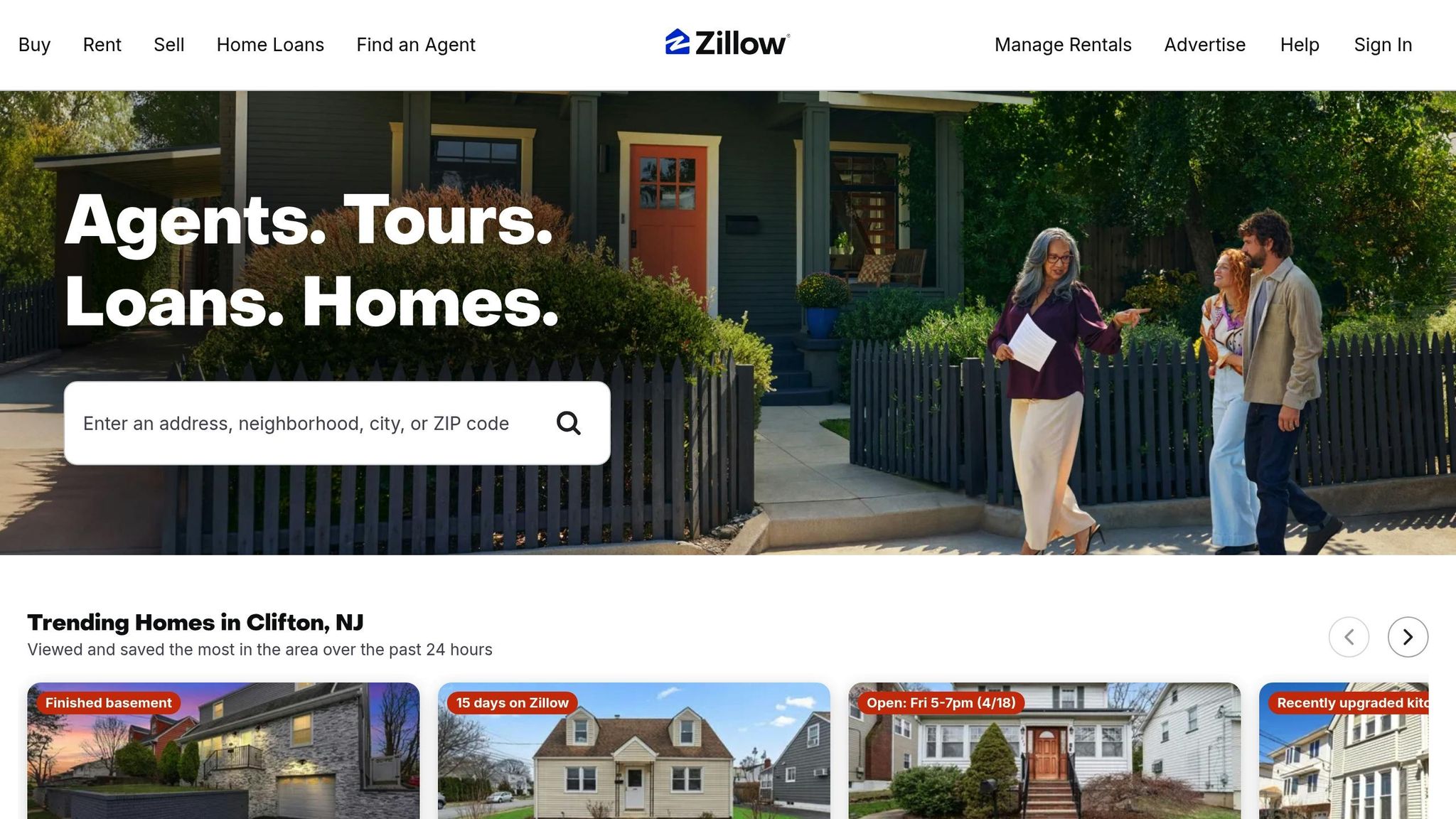
- Harsh Maur
- April 19, 2025
- 5 Mins read
- WebScraping
How Businesses Use Zillow Scraping to Spot Undervalued Properties?
Zillow scraping helps businesses analyze real estate data quickly and efficiently. By automating the collection of property details like prices, square footage, and market trends, companies can identify undervalued properties and make smarter investment decisions. Here’s how it works:
- What It Does: Scrapes Zillow for property data like price, bedrooms, bathrooms, and tax history.
- Why It’s Useful: Tracks real-time price changes and market trends to spot hidden opportunities.
- How It’s Done: Data is exported into spreadsheets or databases for analysis and comparison.
- Automation Benefits: Saves time, reduces human error, and processes thousands of listings in minutes.
Key Tip: Use automated scraping tools to stay ahead in competitive real estate markets while ensuring compliance with Zillow’s rules and U.S. privacy laws.
Data Points Available Through Zillow Scraping

Zillow scraping helps gather essential details from property listings.
Core Property Details
This includes square footage, number of bedrooms and bathrooms, address, listing URL, price, estimated market value, tax history, time listed on Zillow, view and save counts, and property images. These details are crucial for daily workflows like data analysis and decision-making.
For instance, scraping data from Redwood City, CA can provide information such as price, URL, bedrooms, bathrooms, living area, and address. This allows investors to quickly identify listings priced below market value.
Organizing the Data
Data can be exported in two main formats:
- CSV files: Ideal for simple filtering and sorting in tools like Excel.
- JSON files: Useful for API integration, especially when working with nested records.
Location-Based Market Analysis
With this data, businesses can perform tasks like:
- Grouping by ZIP code: Organize properties based on average prices.
- Neighborhood comparisons: Compare similar listings within specific areas.
- Tracking price trends: Observe listing price changes over time by location.
By structuring data this way, businesses can identify areas where properties are priced lower than comparable ones nearby.
Next, we’ll dive into the step-by-step process for collecting and analyzing this data to spot undervalued properties.
Steps to Find Undervalued Properties
Using the core data points from earlier, here’s how to identify properties that might be priced below their true market value.
Collecting and Analyzing Data
Begin by setting clear search parameters - like location, price range, and property features. Then, use a web scraper to pull important details such as listing price, property size, number of bedrooms and bathrooms, and Zillow’s market value estimate.
Key steps include:
- Define your search criteria (e.g., target neighborhoods, price limits, property types)
- Choose the data points you’ll need (e.g., price, square footage, estimated value)
- Run the scraper to gather relevant property listings
- Export the results into a spreadsheet or database, then filter for properties that meet your undervalued benchmarks
Assessing Property Values
Evaluate potential deals by comparing listing prices to Zillow’s market estimates. Look at additional factors like how long the property has been on the market, the number of views and saves, and its price and tax history. These details can help you spot properties that might be priced below their worth.
Why Automation Saves Time
Automation simplifies the process by handling tasks like navigating dynamic content and pagination, tracking price changes, and processing large datasets. It can also export data directly into tools like Google Sheets, where formulas or scripts can instantly flag properties that meet your criteria.
In competitive markets, setting up regular scraping intervals ensures you catch undervalued listings as soon as they appear. This allows you to act quickly and make informed, data-backed decisions.
sbb-itb-65bdb53
Rules and Guidelines for Zillow Scraping
Before starting your Zillow scraping process, make sure to follow these guidelines to ensure compliance and maintain data quality.
Respecting Zillow's Rules
Stick to Zillow's terms by adhering to their robots.txt file, observing rate limits, and using proper request headers.
Handling U.S. Data Privacy
Ensure that scraped data is stored securely, access is restricted, and a clear retention policy is in place to meet U.S. privacy law requirements.
Using Professional Data Collection Services
For a hassle-free experience, consider Web Scraping HQ. They provide:
- Automated QA: Ensures accurate and complete data
- Structured Output: Delivers clean, well-organized property data
- Expert Consultation: Offers guidance on data collection strategies
- Double-Layer QA: Validates data quality for reliability
Comparing Manual vs. Automated Data Collection
Once scraping rules are defined, it's time to evaluate manual and automated methods. The decision between these approaches impacts how efficiently, accurately, and quickly you can identify opportunities. Let’s break down the differences to help you choose the right method.
Manual data collection involves copying property details into spreadsheets by hand. While simple, this method becomes incredibly slow and tedious when managing large property portfolios.
Automated Zillow scraping, on the other hand, handles tasks like paging through listings and retrieving updates automatically. It collects complete data sets with minimal effort.
Performance Comparison Table
| Aspect | Manual Data Collection | Automated Zillow Scraping |
|---|---|---|
| Speed | Minutes per listing | Processes in bulk within minutes |
| Scalability | Limited by team size and workload | Handles tens of thousands of listings daily |
| Accuracy | Susceptible to human error | Highly accurate with automated parsing |
| Cost | Higher costs for data entry staff | Lower cost per listing with automation |
| Compliance | Relies on manual oversight to avoid blocks | Uses IP management strategies to reduce blocking risks |
Automated methods save time, reduce errors, and provide ready-to-use data. With this comparison in mind, you can move forward with confidence in determining the best way to leverage Zillow data for your needs.
Conclusion: Making Better Property Decisions with Zillow Data
This guide has shown how scraping Zillow can provide essential property data, streamline analysis workflows, and ensure compliance with important guidelines. By using Zillow scraping, businesses can pinpoint and assess undervalued properties in today’s fast-moving real estate market.
Automated Zillow scraping enables professionals to review thousands of listings daily. It helps track market trends, spot pricing irregularities, and gather bulk data from multiple sources. This approach is faster and more precise than manual methods, giving users a clear advantage.
FAQs
Find answers to commonly asked questions about our Data as a Service solutions, ensuring clarity and understanding of our offerings.
We offer versatile delivery options including FTP, SFTP, AWS S3, Google Cloud Storage, email, Dropbox, and Google Drive. We accommodate data formats such as CSV, JSON, JSONLines, and XML, and are open to custom delivery or format discussions to align with your project needs.
We are equipped to extract a diverse range of data from any website, while strictly adhering to legal and ethical guidelines, including compliance with Terms and Conditions, privacy, and copyright laws. Our expert teams assess legal implications and ensure best practices in web scraping for each project.
Upon receiving your project request, our solution architects promptly engage in a discovery call to comprehend your specific needs, discussing the scope, scale, data transformation, and integrations required. A tailored solution is proposed post a thorough understanding, ensuring optimal results.
Yes, You can use AI to scrape websites. Webscraping HQ’s AI website technology can handle large amounts of data extraction and collection needs. Our AI scraping API allows user to scrape up to 50000 pages one by one.
We offer inclusive support addressing coverage issues, missed deliveries, and minor site modifications, with additional support available for significant changes necessitating comprehensive spider restructuring.
Absolutely, we offer service testing with sample data from previously scraped sources. For new sources, sample data is shared post-purchase, after the commencement of development.
We provide end-to-end solutions for web content extraction, delivering structured and accurate data efficiently. For those preferring a hands-on approach, we offer user-friendly tools for self-service data extraction.
Yes, Web scraping is detectable. One of the best ways to identify web scrapers is by examining their IP address and tracking how it's behaving.
Data extraction is crucial for leveraging the wealth of information on the web, enabling businesses to gain insights, monitor market trends, assess brand health, and maintain a competitive edge. It is invaluable in diverse applications including research, news monitoring, and contract tracking.
In retail and e-commerce, data extraction is instrumental for competitor price monitoring, allowing for automated, accurate, and efficient tracking of product prices across various platforms, aiding in strategic planning and decision-making.